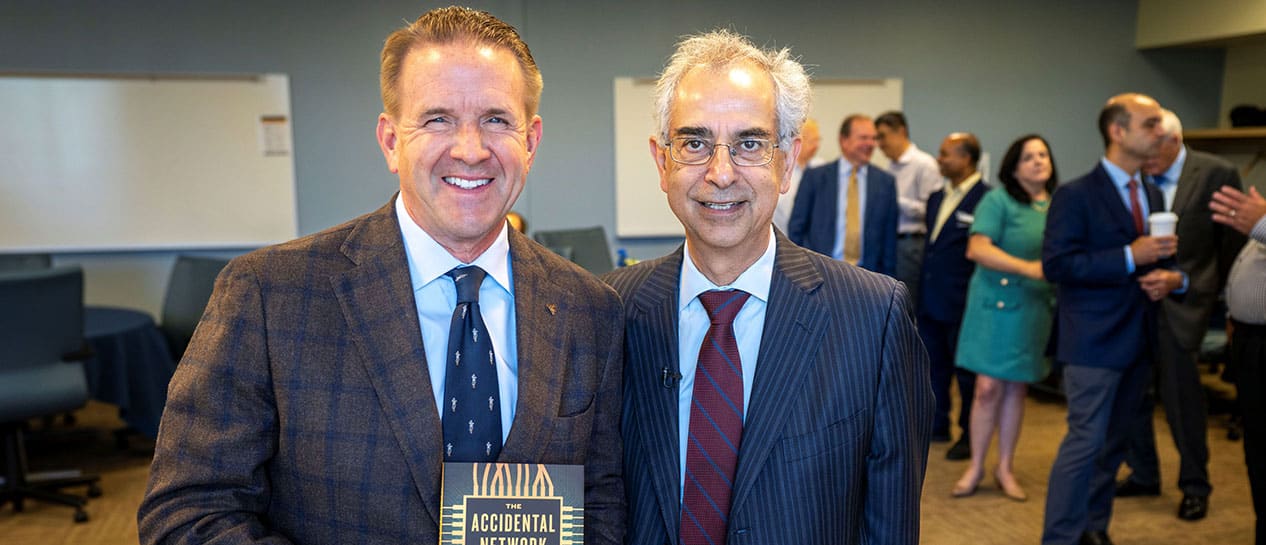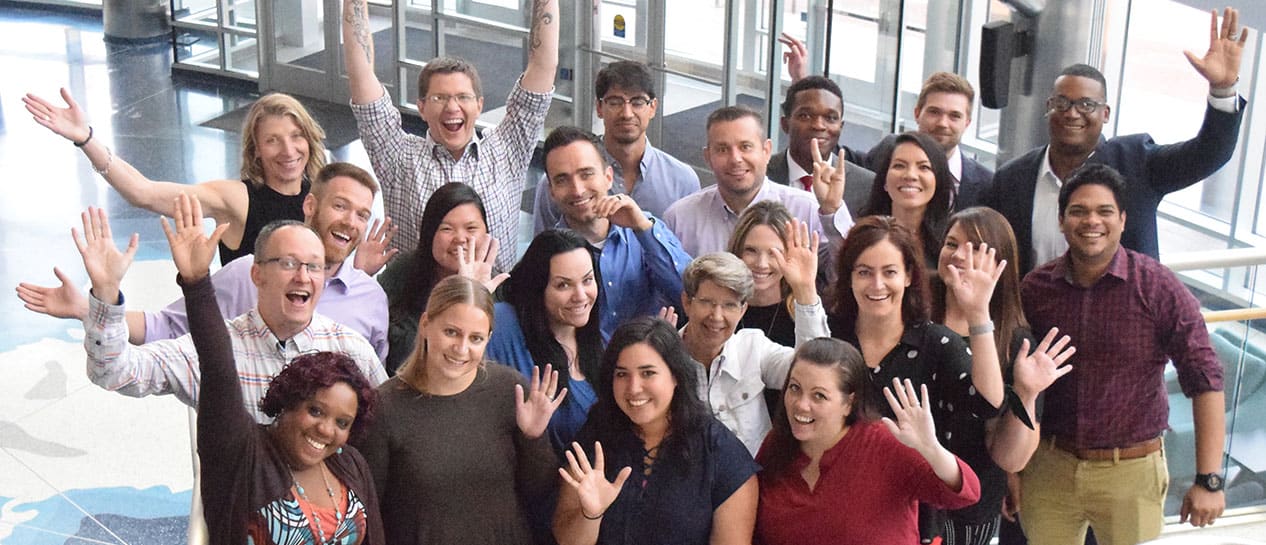This month, we’re proud to hear directly from Rouzbeh Yassini-Fard, widely known as the “father of the cable modem,” whose vision transformed cable television into today’s broadband connectivity industry. His groundbreaking work at LANcity in the 1990s sparked a global communications revolution that fundamentally changed how billions of people connect, work, learn, and live. Drawing on his contributions to Syndeo Institute and celebrating the release of his new book, The Accidental Network: How a Small Company Sparked a Global Broadband Transformation, we celebrate Yassini-Fard’s entrepreneurial past while watching as it prepares the next generation of industry innovators.
As someone whose professional life has been inextricably tied to broadband connectivity, I’m grateful to be able to share some thoughts with friends of Syndeo Institute on the occasion of the organization’s 40th anniversary. (My, how time does fly!)
I’m Rouzbeh Yassini-Fard, founder of the YAS Foundation, a Massachusetts-based philanthropic organization devoted to supporting innovation. My role draws from decades of work in and around our industry, focused on the invention of technology that has created enormous economic growth for a sector we once called “cable television” and now refer to (credit here to Syndeo Institute) as the “connectivity industry.”
My story began as many improbable journeys do: by accident. I had no earthly idea that one day the world would come to refer to me as the “father of the cable modem.” Rather, I came to the U.S. as a college freshman in 1977 to study medicine, aiming to follow in the footsteps of my uncle, a family practice doctor in West Virginia.
But then, something unexpected happened. As an undergraduate student at West Virginia University in Morgantown, I became transfixed by the study of electrical engineering—a field where I realized astonishing innovations could spring from the convergence of physics, mathematics, and the flow of electrical currents. Basically, I fell in love with electronics.
As a university student, I studied with a maniacal, unquenchable curiosity. I often spent the wee hours of the morning at our university’s computer lab, signing up for any available time slot to work out software instructions and understand the intricacy of telecommunications. For cash, I tutored fellow students. My one guilty habit: I didn’t sleep much.
After earning my degree from WVU, I found myself in a position familiar to just about everybody who graduates college: in need of a job. Enter General Electric Corp. The big consumer electronics company hired me to work on advancements in the development of TV sets, focusing initially on video chromatics and early incarnations of integrated circuits that could replace bulky circuit boards. Later, serendipity was set into motion as GE assigned me to a project that introduced me to the essential DNA of cable TV. I had no idea at the time, but my immersion in this fast-growing, fascinating medium would become an early steppingstone along the pathway to today’s modern broadband information ecosystem.
So would my next professional adventure: working for a pair of companies in the New England area that were exploring new ways to distribute information inside the corporate and business arenas. With desktop computers and peripheral devices beginning to populate the business world, the appetite was rising for data networking systems that would let office workers easily and quickly share data with one another. It was the dawning of the Local Area Network (LAN), powered by exciting new technologies that went by names like Ethernet and Token Ring.
The problem: LANs worked only over a very limited distance. There was no instance of high-speed data connectivity happening over a long-distance, city-wide telecommunications network. Nor was there much support for the notion that we could leverage the infrastructure of widely deployed cable television systems as the foundation for the concept. Early on, venture capital investors and the cable industry at large ignored the proposition.
Even so, I had deep faith in the abiding vision that would become the foundational undertaking of my life: to synthesize these two powerful constructs. In 1990 I founded a small company, LANcity, to realize my ambition of providing LAN-style services over an entire metro area. One wire, unlimited possibilities.
I knew exactly where to start: By embracing two essential standards as the foundation for achieving my vision. One was the prevailing LAN architecture known as Ethernet. The other was the prescribed lane of travel for cable television channels: a 6 MHz pathway. A deep understanding of these key technologies enabled me to become the right entrepreneur at the right time (and with the right passion) to pursue what would become a monumental, disruptive and wholly revolutionary technology, one that now produces incalculable economic contributions across the world, and enables dynamic new applications from Silicon Valley entrepreneurs ranging from media streaming to telecommuting to connected healthcare…and many more.
It was our faith and commitment to my core vision that propelled LANcity, leading us to overcome a seemingly bottomless list of obstacles, ranging from the lack of external funding to a lengthy list of real-world deployment challenges. In the end, our work sparked a global communications transformation that opened the door for every connected home and user to participate not just as consumers of information, but as producers in the global economy. In doing so, we set the stage for individual citizens to play mainstay roles in the forthcoming AI revolution.
In every case, we hewed to a set of principles I often talk about with entrepreneurs and college students today.
Think big. Embrace a core vision for addressing a real problem confronting real human beings. Although it may seem outlandish or audacious to others, it will stand as your own North Star to achieving the improbable.
Build something special. Focus on your product and how it can resolve a customer’s needs. Avoid the trap of devoting your intellect and resources to marketing-speak and impressive-seeming Powerpoint demos. Let your product tell your story.
Listen to your customers. Probe with genuine curiosity about what your customer wants and needs. Don’t resist or push back when ambitions seem unreachable. The things your customers want are the things that will drive your success.
Make friends with failure. There were countless times during our journey where we embraced unexpected consequences. Setbacks and failures are your teachers. Learning from them will rocket you far beyond what your competitors are doing.
Finally, pursue your vision with relentless conviction. Don’t make material rewards the focal point of your work. Achieve your vision, and the rewards will follow. It doesn’t work the other way around. My goal was to make one billion human lives better—not to make one billion dollars.
Earlier this year, I chronicled this journey in a book titled The Accidental Network: How a Small Company Sparked a Global Broadband Transformation. Written with business journalist Stewart Schley, the book chronicles the creation of a communications platform that has driven incalculable advances in economic output across the globe.
Thoughtful descriptions of the book have come from people who witnessed and lived through this same revolution. As the journalist and author Mark Robichaux commented, “The cable modem did more than speed up the Internet—it accelerated the future. This book tells how it all began.” Similarly, I treasure the words from the former chairman of the Federal Communications Commission Michael K. Powell, who was later president and CEO of NCTA – The Internet & Television Association. Powell called broadband “the most beloved technology in the world,” and wrote that “Yassini-Fard, famed inventor of the cable modem, expertly tells one of the great American success stories.”
The title of the book is significant. The word “accidental” attests to the improbable, wondrous and unexpected convergence of events and advancements that paved the way for the cable telecommunications transformation to flourish. While my team was laboring deep into the night to solve complicated issues around long-distance data networking, other important developments were occurring elsewhere. The rise of the personal computer, the early days of online services, the invention of the World Wide Web, and breakthroughs around data networking standards gave rise to a sort of perfect storm of activity.
As these events swirled, the industry once known as “cable television” was itself mutating into something grander and more ambitious. The industry’s embrace of fiber-optic networking, the revolutionary work to digitize the cable pipe, and, importantly, the willingness among leading CTOs to experiment with entirely new business propositions gave rise to what we now call the “connectivity industry.” It’s remarkable to consider that, today, the business of broadband-over-cable generates significantly more revenue for the U.S. cable industry than the original conceit of selling television channels and video services.
This industrial transformation—from TV to telecommunications—now touches billions of lives in diverse and extraordinary ways, ranging from online education to remote work to environmental caretaking to new ways of delivering streamed entertainment. The everyday video conference call, the rapid-fire downloading of documents and media content, and the ability to stay in touch with friends and family regardless of geography are elements of modern life we now tend to take for granted. Connectivity at the speed of broadband has become as vital to the modern human condition as electricity—one reason I’m now devoted to making broadband connectivity virtually ubiquitous across our country and the world.
Meanwhile, innovation never stops. Today, I’m more enthused than ever about the role of the connectivity industry in supporting almost unimaginable advancements tied to the convergence of high-speed networking and artificial intelligence. Of special interest to me are possibilities surrounding the convergence of broadband, AI, and personalized healthcare. Innovations in this area promise to make generational contributions to the well-being of people everywhere—literally rewriting the rules of medicine and healthcare.
In this regard, I am hopeful that the book will serve as a living roadmap that helps inspire and instruct a new generation of entrepreneurs. Just as I experienced, there are fortuitous and positive “accidents” happening today that present a robust new toolbox of possibility to those willing to undertake something audacious, disruptive, and game-changing.
The key is to see the hazy outlines of possibilities others may overlook. A coming generation of entrepreneurs is likely to discover something in the convergence of AI, connectivity, the human capacity for invention and the power of our new broadband alphabet that contains the seeds for stunning new innovations. I guarantee the possibilities are there, and I cannot wait to see who’s out there to discover them.
Rouzbeh Yassini-Fard’s journey from electrical engineering student at West Virginia University to the inventor of technology that powers today’s connected world offers invaluable lessons for the next generation of industry innovators. His emphasis on thinking big, building something special, listening to customers, embracing failure, and pursuing vision with relentless conviction exemplifies the entrepreneurial spirit that has driven this industry forward. At Syndeo Institute, we are committed to preserving these stories and using them to inspire and prepare tomorrow’s leaders in media and telecommunications. Through resources like our Oral History collection and profiles of industry pioneers, we connect the entrepreneurial past to an innovative future. Get more information and purchase your copy of The Accidental Network here.



